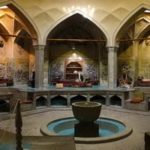Hammam "Sheykh Baha'I"
The hammam Sheykh Baha'i it is the most famous among the ancient hammams of the city of Esfahan. It was designed in the 1616 by Sheikh Baha'i, great Iranian scientist of the time Safavid, during the reign of Shah Abbas I.
This monument has been inscribed since 1998 among the works of the Iranian national heritage. The water in this hammam was heated by means of a single candle which was always lit.
The system of ceramic pipelines in the basement of this hammam, through a natural suction system, directed some gases such as methane and sulfur oxide to the hammam cistern torch, where the gas burned and served as a heating source. Archaeologists' studies show that the wastewater from the city of Esfahan, through wastewater collection ducts, entered the hammam boiler; probably Sheykh Baha'i had designed the hammam cistern so that the local wastewater turned into methane gas. Thus even a part of the silt settled in this area was used for the production of biogas. Probably these gases were also collected directly from the waste products coming from the hammam itself.
During the restoration of the house of Sheykh Baha'i, which is located near the hammam caldarium, ceramic floor coverings and communicating wells that probably have to do with the design of the hammam were found in the floor. Therefore the water of this hammam was heated with an "air-gas" system, that is by means of the methane gas of the waste water of the Jame mosque and of the oil dripping of the oil mill of Sheykh Baha'i that was in the vicinity of the 'hammam and other wastewater conveyed to the boiler of the hammam. But how could a single candle heat an entire water tank? The most recent research has revealed that the tank of this hammam was of gold: in consideration of the fact that gold is, among the metals, the major conductor of heat, a small amount of heat was enough to produce a large amount of energy and heat the hammam water.



